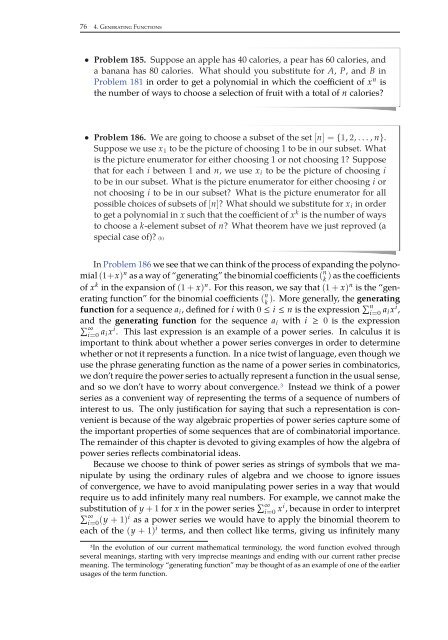Combinatorics Through Guided Discovery, 2004a
Combinatorics Through Guided Discovery, 2004a
Combinatorics Through Guided Discovery, 2004a
Create successful ePaper yourself
Turn your PDF publications into a flip-book with our unique Google optimized e-Paper software.
76 4. Generating Functions<br />
• Problem 185. Suppose an apple has 40 calories, a pear has 60 calories, and<br />
a banana has 80 calories. What should you substitute for A, P, and B in<br />
Problem 181 in order to get a polynomial in which the coefficient of x n is<br />
the number of ways to choose a selection of fruit with a total of n calories?<br />
• Problem 186. We are going to choose a subset of the set [n] ={1, 2,...,n}.<br />
Suppose we use x 1 to be the picture of choosing 1 to be in our subset. What<br />
is the picture enumerator for either choosing 1 or not choosing 1? Suppose<br />
that for each i between 1 and n, we use x i to be the picture of choosing i<br />
to be in our subset. What is the picture enumerator for either choosing i or<br />
not choosing i to be in our subset? What is the picture enumerator for all<br />
possible choices of subsets of [n]? What should we substitute for x i in order<br />
to get a polynomial in x such that the coefficient of x k is the number of ways<br />
to choose a k-element subset of n? What theorem have we just reproved (a<br />
special case of)? (h)<br />
In Problem 186 we see that we can think of the process of expanding the polynomial<br />
(1+x) n as a way of “generating” the binomial coefficients ( n )<br />
k<br />
as the coefficients<br />
of x k in the expansion of (1 + x) n . For this reason, we say that (1 + x) n is the “generating<br />
function” for the binomial coefficients ( n ).<br />
k<br />
More generally, the generating<br />
function for a sequence a i , defined for i with 0 ≤ i ≤ n is the expression ∑ n<br />
i=0 a ix i ,<br />
and the generating function for the sequence a i with i ≥ 0 is the expression<br />
∑ ∞<br />
i=0 a ix i . This last expression is an example of a power series. In calculus it is<br />
important to think about whether a power series converges in order to determine<br />
whether or not it represents a function. In a nice twist of language, even though we<br />
use the phrase generating function as the name of a power series in combinatorics,<br />
we don’t require the power series to actually represent a function in the usual sense,<br />
and so we don’t have to worry about convergence.3 Instead we think of a power<br />
series as a convenient way of representing the terms of a sequence of numbers of<br />
interest to us. The only justification for saying that such a representation is convenient<br />
is because of the way algebraic properties of power series capture some of<br />
the important properties of some sequences that are of combinatorial importance.<br />
The remainder of this chapter is devoted to giving examples of how the algebra of<br />
power series reflects combinatorial ideas.<br />
Because we choose to think of power series as strings of symbols that we manipulate<br />
by using the ordinary rules of algebra and we choose to ignore issues<br />
of convergence, we have to avoid manipulating power series in a way that would<br />
require us to add infinitely many real numbers. For example, we cannot make the<br />
substitution of y +1for x in the power series ∑ ∞<br />
i=0 xi , because in order to interpret<br />
∑ ∞<br />
i=0 (y +1)i as a power series we would have to apply the binomial theorem to<br />
each of the (y +1) i terms, and then collect like terms, giving us infinitely many<br />
3In the evolution of our current mathematical terminology, the word function evolved through<br />
several meanings, starting with very imprecise meanings and ending with our current rather precise<br />
meaning. The terminology “generating function” may be thought of as an example of one of the earlier<br />
usages of the term function.


















